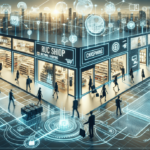Comparing Omnichannel Fulfillment and Multichannel Fulfillment
In today's fast-paced digital age, businesses are constantly seeking ways to enhance their supply chain logistics and cater to the evolving needs of their customers. Two prominent fulfillment strategies that have gained traction in recent years are omnichannel fulfillment and multichannel fulfillment. While both strategies aim to deliver a seamless customer experience, they possess distinct differences. This article delves into the fundamentals of omnichannel and multichannel fulfillment, explores their benefits and challenges, incorporates relevant data, and offers best practices for successful implementation.
Understanding the Basics: What is Omnichannel and Multichannel Fulfillment?
Before delving into the key differences, it's essential to define omnichannel and multichannel fulfillment.
Omnichannel fulfillment is a strategy where businesses seamlessly integrate all their sales channels—online, brick-and-mortar, and mobile—to provide customers with a consistent and personalized experience. This integration allows customers to purchase products through various channels and choose their preferred delivery or pickup method, such as in-store pickup, home delivery, or other convenient locations.
Conversely, multichannel fulfillment involves managing separate sales channels independently. For example, a business may operate both a physical store and an online store, but each channel functions independently with distinct inventory, shipping, and returns processes.
While both omnichannel and multichannel fulfillment offer advantages, omnichannel fulfillment is increasingly favored due to its ability to deliver a seamless and personalized customer experience. By integrating all channels, businesses gain a deeper understanding of customer preferences and behaviors, enabling tailored offerings and fostering customer loyalty. According to a recent Retail Dive report, companies that effectively implement omnichannel strategies see a 91% higher customer retention rate compared to those that don't.
Key Differences between Omnichannel and Multichannel Fulfillment
The primary distinction between omnichannel and multichannel fulfillment lies in the level of integration among the various channels. Omnichannel fulfillment ensures seamless integration across all channels, enabling unified inventory management and customer experience.
In contrast, multichannel fulfillment operates each sales channel independently, with separate inventories and processes. This separation can lead to inconsistencies in product availability and customer service across different platforms.
Another notable difference is the flexibility in delivery and return options. Omnichannel fulfillment offers a variety of options, allowing customers to choose how they receive and return their orders, such as home delivery, in-store pickup, or other convenient locations. On the other hand, multichannel fulfillment typically provides more traditional delivery or pickup methods without the same level of flexibility.
Furthermore, omnichannel fulfillment offers a higher degree of personalization. Customers can access their order history and preferences across all channels, facilitating targeted marketing and personalized recommendations. Multichannel fulfillment, due to its independent operation of channels, may lack these personalized touchpoints.
Implementing an omnichannel strategy also demands a more robust technological infrastructure, including integrated inventory management systems, order management systems, and advanced logistics software. Multichannel fulfillment may not require such extensive technology, as each channel can function with its own systems and processes.
Benefits of Omnichannel Fulfillment for Businesses
- Enhanced Customer Experience: Omnichannel fulfillment provides a unified and personalized shopping experience, increasing customer satisfaction and loyalty.
- Improved Inventory Management: Centralized inventory systems reduce the risk of overstocking or stockouts by providing real-time visibility across all channels.
- Reduced Shipping Costs: Utilizing physical stores as distribution centers can lower shipping expenses and improve delivery speeds.
- Valuable Customer Insights: Integrated data from all channels offer insights into customer behavior and preferences, enabling more effective marketing strategies.
- Expanded Market Reach: Offering multiple purchasing channels, including online marketplaces and mobile apps, allows businesses to reach a broader audience.
- Operational Efficiency: Streamlined operations through integrated systems lead to cost savings and increased profitability.
For instance, businesses implementing omnichannel strategies report up to a 20% increase in sales, as noted by a 2023 Forbes Business Council article.
Benefits of Multichannel Fulfillment for Businesses
- Cost-Effectiveness: Multichannel fulfillment can be more affordable for smaller businesses that lack the resources to implement comprehensive omnichannel strategies.
- Targeted Marketing: Managing each channel independently allows businesses to create tailored marketing campaigns for each platform, potentially increasing sales.
- Flexible Delivery and Return Options: Offering various delivery and return methods enhances customer satisfaction by accommodating different preferences.
- Market Expansion: Selling through multiple channels enables businesses to enter new markets and reach diverse customer segments.
According to a Statista report, multichannel retailers experience an average sales growth rate of 12% annually.
Understanding the Role of Technology in Omnichannel and Multichannel Fulfillment
Technology is pivotal in both omnichannel and multichannel fulfillment strategies. For omnichannel fulfillment, businesses require a centralized inventory management system that provides real-time tracking across all channels. This ensures product availability regardless of the purchase point and facilitates efficient order fulfillment.
In multichannel fulfillment, while an inventory management system is still necessary, it does not need to be as integrated, as each channel operates independently.
Automation plays a significant role in enhancing fulfillment processes. Automated picking and packing systems increase order accuracy and speed, reducing the likelihood of errors and improving overall efficiency.
Additionally, data analytics tools enable businesses to gain actionable insights into customer behavior, allowing for the personalization of marketing efforts and inventory optimization. Real-time order tracking systems also enhance transparency, providing customers with up-to-date information on their order status and delivery.
Integrating advanced technologies such as artificial intelligence (AI) and machine learning can further optimize inventory management and predict consumer demand patterns. For example, AI-driven predictive analytics can help businesses forecast inventory needs, reducing the risk of stockouts or excess inventory.
How Omnichannel Fulfillment Impacts Customer Experience
Omnichannel fulfillment significantly enhances the customer experience by offering unparalleled convenience and personalization. Customers benefit from multiple touchpoints, allowing them to interact with the brand through their preferred channels seamlessly.
For example, a customer might browse products on a mobile app, add items to their cart, and choose to pick up the order at a local store. This seamless transition across channels reduces friction in the purchasing process, leading to higher conversion rates and increased customer satisfaction.
Moreover, omnichannel systems enable personalized marketing efforts. By analyzing customer data across all channels, businesses can deliver targeted promotions and recommendations, enhancing the overall shopping experience.
A study by Salesforce indicates that 76% of consumers expect companies to understand their needs and expectations, which omnichannel fulfillment can effectively address.
How Multichannel Fulfillment Impacts Customer Experience
While multichannel fulfillment may not provide the same level of seamless integration as omnichannel fulfillment, it still positively influences the customer experience by offering flexibility and choice.
Customers appreciate the ability to engage with a business through multiple channels, choosing the most convenient platform for their needs. For instance, a customer might prefer purchasing products through a website but choose to pick up the items in-store for immediate availability.
Additionally, multichannel fulfillment allows businesses to tailor their services to the unique demands of each platform, potentially enhancing customer satisfaction within each channel.
However, the lack of integration may result in inconsistencies in service levels and customer interactions across different channels, which can impact overall satisfaction if not managed effectively.
Challenges Associated with Implementing Omnichannel Fulfillment
- High Implementation Costs: Establishing an integrated system requires significant investment in technology, infrastructure, and training.
- Complexity in Integration: Harmonizing various sales channels, inventory systems, and logistics can be technically challenging.
- Data Management: Ensuring accurate and real-time data across all channels necessitates robust data management practices.
- Staff Training: Employees must be trained to handle multi-channel operations and customer service inquiries efficiently.
- Scalability Issues: As the business grows, maintaining seamless integration across an expanding number of channels can become increasingly difficult.
Addressing these challenges requires strategic planning, investment in scalable technologies, and continuous monitoring to ensure the system operates smoothly. Failure to effectively implement an omnichannel strategy can lead to operational inefficiencies and negatively impact customer satisfaction.
Challenges Associated with Implementing Multichannel Fulfillment
- Inconsistent Customer Experience: Managing multiple channels independently can lead to inconsistencies in service and customer interactions.
- Inventory Discrepancies: Without centralized inventory management, there is a higher risk of overstocking or stockouts across different channels.
- Increased Operational Costs: Maintaining separate systems and processes for each channel can result in higher operational expenses.
- Complex Marketing Strategies: Developing and managing distinct marketing campaigns for each channel requires additional resources and coordination.
Businesses must carefully manage these challenges to ensure that each channel operates efficiently and delivers consistent value to customers. Implementing robust inventory management and integrating certain processes can help mitigate some of these issues.
Best Practices for Implementing Omnichannel Fulfillment
- Invest in Integrated Technology: Utilize comprehensive inventory and order management systems that provide real-time data across all channels.
- Develop Robust Logistics: Establish efficient shipping and returns processes that can handle various delivery methods and locations.
- Train Staff Effectively: Ensure employees are well-versed in multi-channel operations and customer service protocols.
- Leverage Data Analytics: Continuously analyze customer data to refine marketing strategies and enhance the shopping experience.
- Ensure Consistent Branding: Maintain a unified brand identity and messaging across all channels to strengthen brand recognition and loyalty.
- Enhance Customer Support: Provide seamless support across channels, ensuring customers receive timely and effective assistance regardless of how they engage with the business.
Implementing these best practices can help businesses navigate the complexities of omnichannel fulfillment, ensuring a cohesive and efficient operation that meets customer expectations.
Best Practices for Implementing Multichannel Fulfillment
- Targeted Marketing: Develop specific marketing campaigns tailored to each channel to maximize engagement and sales.
- Consistent Pricing and Availability: Ensure that product pricing and availability are uniform across all channels to avoid customer confusion.
- Centralized Inventory Tracking: Implement an inventory management system that monitors stock levels across all channels in real-time to prevent overstocks and stockouts.
- Clear Shipping and Returns Policies: Establish transparent and accessible shipping and returns policies for each channel to build trust and reliability.
- Monitor Channel Performance: Regularly assess the performance of each channel to identify areas for improvement and optimize resource allocation.
- Integrate Customer Feedback: Collect and analyze customer feedback from each channel to enhance service quality and address any issues promptly.
These strategies can help businesses effectively manage multiple channels, ensuring each operates efficiently while contributing to overall business growth.
Case Studies: Successful Implementation of Omnichannel and Multichannel Fulfillment Strategies
Several businesses have successfully implemented omnichannel and multichannel fulfillment strategies, resulting in increased sales and enhanced customer loyalty.
Sephora has adopted an omnichannel strategy that allows customers to purchase products online, in-store, or via their mobile app, with options for in-store pickup or home delivery. This integrated approach has led to a 150% increase in sales among customers who engage across multiple channels, as highlighted in a Retail Dive article.
Best Buy employs a multichannel strategy that offers integrated online and in-store experiences, enabling customers to purchase products online and pick them up in-store, with options for returns either in-store or by mail. This approach has resulted in increased sales across all channels and improved customer satisfaction, according to a Forbes Business Council.
Walmart has successfully integrated its online and physical store operations, offering services such as buy online, pick up in-store (BOPIS), curbside pickup, and same-day delivery. This omnichannel fulfillment approach has contributed to Walmart's continuous growth in e-commerce, which saw a 12% increase in 2023 as reported by Statista.
Future Trends in Omnichannel and Multichannel Fulfillment
As technology advances, the landscape of omnichannel and multichannel fulfillment continues to evolve. Emerging trends include the integration of artificial intelligence (AI) and machine learning to optimize inventory management and provide personalized product recommendations. AI-driven demand forecasting can enhance inventory accuracy, reducing the risk of stockouts or excess inventory.
Additionally, the incorporation of virtual and augmented reality (VR/AR) is set to revolutionize the shopping experience, offering customers immersive and interactive ways to engage with products before making a purchase. For example, AR applications can allow customers to visualize how furniture fits in their home or how apparel looks on them virtually.
Sustainability is also becoming a significant focus, with businesses striving to implement eco-friendly fulfillment practices. This includes utilizing sustainable packaging materials, optimizing delivery routes to reduce carbon emissions, and adopting circular economy principles to minimize waste.
Furthermore, the rise of last-mile delivery innovations, such as drone deliveries and autonomous vehicles, is anticipated to enhance delivery speed and efficiency, providing customers with faster and more reliable service.
Conclusion: Which Strategy is Right for Your Business?
The decision to implement an omnichannel or multichannel fulfillment strategy hinges on various factors, including the size of the business, available resources, customer preferences, and the nature of the products being sold.
Omnichannel fulfillment is well-suited for larger businesses with the capacity to handle the complexity of integrating multiple channels. It offers a seamless and personalized customer experience, driving higher customer loyalty and sales. However, it requires significant investment in technology, infrastructure, and staff training.
Multichannel fulfillment, on the other hand, can be a more cost-effective option for smaller businesses with limited resources. It allows businesses to reach customers through various platforms without the need for extensive integration. While it may not provide the same level of personalization and seamless experience as omnichannel fulfillment, it still offers increased flexibility and market reach.
Ultimately, businesses should assess their specific needs, resources, and long-term goals when choosing between omnichannel and multichannel fulfillment. Whichever strategy is selected, investing in the necessary technology, infrastructure, and staff training is crucial to ensure a smooth customer experience and maximize sales across all channels.




















